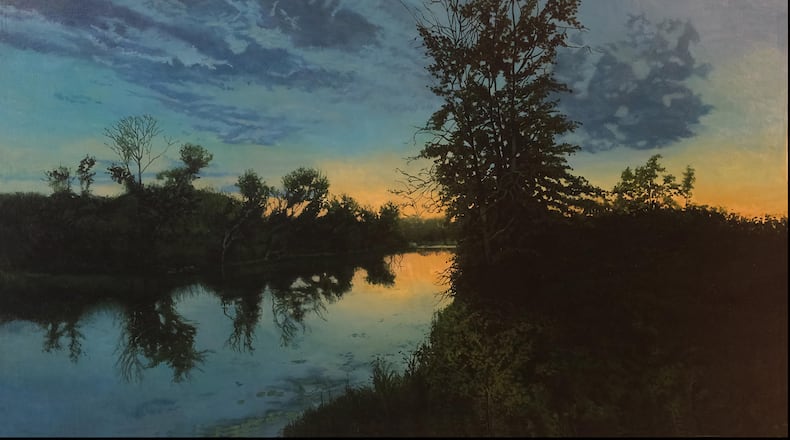This story was originally published by ArtsATL.
“South of the Yellowstone,” Don Pollack’s solo exhibition at Marcia Wood Gallery through March 1 — his eighth with the gallery and Wood’s second in the gallery’s new location on Miami Circle — reads as a collaboration among three people: Pollack, his father and his grandfather. Four, if you include the place that inspired them all.
By combining artifact, memory and his own experience in a manner traditionally considered the domain of Southern writers and artists, the Chicago-born Pollack renders place as a character in his story of time, the land and his family’s presence in both.
Pollack’s story begins when his grandfather, upon his return home from World War I, left his native Chicago for the frontier of Buffalo, Wyoming, south of the Yellowstone River. There he built a cabin and rebuilt himself as a homesteader on 640 acres of land, all of which remain in the artist’s family (even though grandfather returned to Chicago). This two-part body of work in drawing and painting originates with his grandfather’s land surveys and maps from around 1920 and hand-drawn architectural renderings his father made around 1960 for a house that was never realized.
Credit: Photo courtesy of Marcia Wood Gallery
Credit: Photo courtesy of Marcia Wood Gallery
Twelve graphite drawings on these inherited papers mounted in his own elegant artist-made frames open the show in — as he writes in his statement — an “homage to (his) inherited passion for design and … of wild places.” Beautifully drawn in realistic and richly detailed graphite, animals native to this area visually share the dwellings his relatives aspired to inhabit. Pollack overlays bighorn sheep, bison, mountain goats (at least to my uninitiated eye) and grizzly bears onto and into his drawings, and, doing so, he vivifies the place, making it his own in the present with often-wry humor in his titles and juxtapositions.
In conversation at the gallery, he told me he was inspired by, or at least found precedence in, Robert Rauschenberg’s “Erased de Kooning Drawing” (1953) in which the artist did exactly that — acquired a drawing from the titan of abstract expressionism and, with his permission, erased it.
Credit: Photo courtesy of Marcia Wood Gallery
Credit: Photo courtesy of Marcia Wood Gallery
Pollack’s original idea was to erase into his ancestors’ drawings to create something new but ultimately decided to work with them. In “Homestead, arroyo, Johnson Co., Wyoming” (2024), Pollack overlays an image of the actual land over its surveyed representation. His grandfather had marked his own plot on the survey with a square outline of red pencil; Pollack drew an arroyo that exists on the property over his relative’s markings, highlighting the square in a nod to fellow Chicagoan Frank Lloyd Wright’s signature red square.
Credit: Photo courtesy of Marcia Wood Gallery
Credit: Photo courtesy of Marcia Wood Gallery
In the main gallery, Pollack takes a wider view of place with four virtuoso, midsize (the longest dimension is 60 inches) oils on canvas. Titled after the places that inspired them, three reflect the grandeur of Wyoming: the Snake River, the north branch of the Shoshone and the Bighorn Mountains.
The sublime “Galien River Nocturne,” the strongest of the four, is set in Michigan, not Wyoming, where his grandfather would later build a home. With a liminal, twilit mood of ethereal blues, near-black greens and water-reflected apricot sky, Pollack conjures the loneliness of such beauty, the unreachable quality that beauty and awe and time can lend to the scene right before our eyes. In these gorgeous paintings, the presence of the artist is implicit in these otherwise empty spaces. But, just like him, as we stand before them, we, too, are present in the space, but not of it.
“South of the Yellowstone” is not a sweeping take on the history of a place, nor is it meant to be; It is a more intimate one. Though the presence of those who came before — Shoshone, Cheyenne, Lakota — remains in place names and our own wider American history, Pollack chooses to begin his story with his own family’s interaction with this land, creating a personal exploration of his own inheritance that opens this specific place for the rest of us, in the way the personal, when portrayed well, becomes universal. Pollack captures us with beauty and, yes, a skill likely inherited from the two men to whom, with this show, he tips his hat.
ART REVIEW
Don Pollack: “South of the Yellowstone”
Through March 1 at Marcia Wood Gallery. 11 a.m.-5 p.m. Tuesdays through Fridays, noon-5 p.m. Saturdays. 761 Miami Circle NE, Suite D, Atlanta. 404-827-0030, marciawoodgallery.com.
::
Donna Mintz is a visual artist who writes about art and literature. A current studio artist at Atlanta Contemporary, her work is in the permanent collections of the High Museum of Art and MOCA GA. Her writing has appeared in the Sewanee Review, Sculpture magazine, The Atlanta Journal-Constitution, Burnaway and ArtsATL, where she is a regular contributor. She recently completed a book on the life of writer James Agee and holds an MFA from Sewanee’s School of Letters at the University of the South.
Credit: ArtsATL
Credit: ArtsATL
MEET OUR PARTNER
ArtsATL (artsatl.org) is a nonprofit organization that plays a critical role in educating and informing audiences about metro Atlanta’s arts and culture. ArtsATL, founded in 2009, helps build a sustainable arts community contributing to the economic and cultural health of the city.
If you have any questions about this partnership or others, please contact Senior Manager of Partnerships Nicole Williams at nicole.williams@ajc.com.
About the Author
Keep Reading
The Latest
Featured






